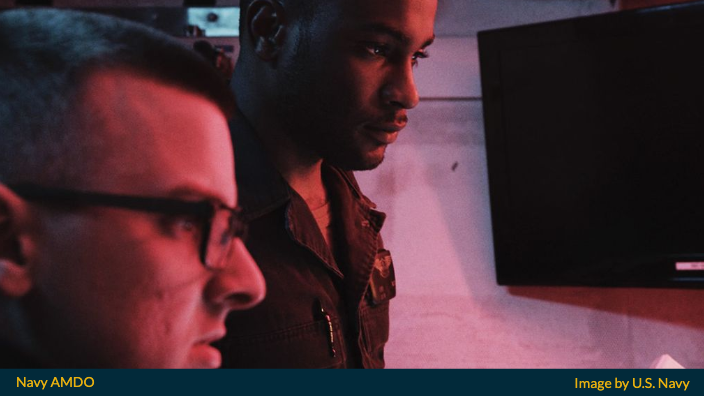Last Updated on March 4, 2024
This guide provides information that will help you with your decision to become a Navy Aviation Maintenance Duty Officer during Fiscal Year 2024.
An Aviation Maintenance Duty Officer (AMDO) is a Restricted Line Officer in the United States Navy who is in-charge of the team that conducts the maintenance and repair of Naval aviation assets. The Navy AMDO designator code is 1520.
As an AMDO, you could find yourself working on a ship at sea or at an air station on shore – at locations around the world.
Let us jump right into the details.
What Does A Navy AMDO Do?
In the Navy, Aerospace Maintenance Duty Officers (AMDOs) create, develop, and implement material and maintenance management policies and procedures to maintain naval aircraft, attendant systems, airborne weapons, and associated support equipment across Navy aviation.

Navy AMDOs ensure the safety of passengers and the effective operation of planes on a daily basis. Their tasks include the following:
- Ensuring that all airplane maintenance has been completed appropriately
- Providing operational assistance to aviation personnel and aircraft
- Influencing future aviation weapon system designs to minimize, simplify, or eliminate maintenance tasks
- Managing all materials and personnel required to support flight operations
AMDOs are involved in all elements of system acquisitions and support as Program Managers and Logistics specialists as they advance in their careers, in addition to serving in fleet maintenance organizations.
Members of the Navy Flight Support team have a range of responsibilities, allowing them to participate in nearly every area of Naval Aviation.
AMDOs may be found in a variety of commands across the acquisition process, including NAVAIR, NAVSEA, SPAWAR, and DCMA.
Senior AMDOs eventually compete with other Acquisition Corps members for the position of Major Program Manager for acquisition commands or Major Commands such as the larger Fleet Readiness Centers.
Navy AMDO Career Path
Junior AMDO
AMDOs begin their professional education with a nine-week school at NAS Whiting Field, FL’s Aviation Maintenance Officer School.
Junior-grade AMDOs that are Ensign to Lieutenant (O1-O3) are then assigned to operational fleet billets in squadrons and Aircraft Intermediate Maintenance Departments both on land and at sea.
The junior AMDOs are required to master the essential aviation maintenance capabilities, obtain their initial Level 1 DAWIA certifications, and, most significantly, achieve their Professional Aviation Maintenance Officer insignia throughout this sequence of tours.
As part of this professional development phase, a junior AMDO will serve at least 30 months in an O-level activity (fleet squadron, FRS, or shore squadron) and 18 months in a maintenance activity such as a CVN AIMD, AIMU, or shore FRC.
Junior AMDOs continue their academic growth by taking a variety of maintenance/logistics centered service courses as well as acquisition workforce courses.
This “constant learning” prepares students for work responsibilities and positions them to pursue a technical or business-oriented master’s degree.
Finally, while Production, Quality, and Manufacturing (PQM) is the primary acquisition field for junior AMDOs, they will cycle through billets that allow them to obtain certification in a variety of acquisition fields such as IT, Financial Management, Program Management, and Lifecycle Logistics depending on tour assignments.
Mid-Grade AMDO
The Advanced Aviation Maintenance Management course is a continuation of professional development for mid-level AMDOs.
CVN AIMD Assistant Maintenance Officers and Production Control Officers (both IM-1), Carrier Air Wing Maintenance Officers (CAGMO), L-Class ship AIMD Officers (LHD DH), and Squadron Assistant Maintenance Officers are all career milestones for mid-level AMDOs (AMO).
As previously stated, mid-grade AMDOs will almost certainly have at least a Level 2 in PQM as well as other Level 1 and 2 acquisition field core certifications.
AMDOs are expected to apply for and be accepted into the Acquisition Corps after being promoted to LCDR (AC).
The Naval Postgraduate School, the Naval War College, the Air Force Institute of Technology, and the Industrial College of the Armed Forces are all options for Lieutenant Commanders and Commanders interested in pursuing post-graduate academic study.
AMDO Commander
AMDO Commanders compete in a highly selective procedure for the positions of CVN AIMD Officer, FRC Components Officer, JSF Deputy Squadron Commander, and Officers-in-Charge on a regular basis.
In the Unrestricted Line, this is the equivalent of a Commander Command tour.
When promoted to CDR, AMDO CDRs are immediately screened for acquisition command eligibility and can then apply for O5 Acquisition Command (FRC WESTPAC (NAPRA), DCMA, FRC West, and FRC Northwest).
A Commander-level acquisition tour is critical preparation for opportunities as an AMDO Captain to eventually qualify for Major Program Manager or Commanding Officer of a Fleet Readiness Center or larger Defense Contract Management Agency operation.
AMDO Captain
AMDO Captains work as high-level staff at OPNAV, NAVAIR, NAVSEA, CNATT, DCMA, and COMNAVAIRFORCES.
AMDO and AEDO (Aerospace Engineering Duty Officer) Captains integrate into a single competitive category, the 1500 designator, after two years of service in grade.
How To Become A Navy AMDO
To become a Navy AMDO, applicants must be American citizens no older than 42 years old with a qualifying business-related or technical Bachelor’s degree and score at least a 45 on the Officer Aptitude Rating (OAR) exam.
Below are the basic eligibility requirements for Navy AMDO applicants. These requirements are current as of July 2019, per Navy Personnel Command. No updates have been issued so far.
Navy AMDO Eligibility Requirements
| Citizenship | Navy AMDO applicants must be United States citizens. |
| Gender | Navy AMDO applications are open to men and women. |
| Age | Navy AMDO applicants must be within 19 to 42 years of age upon time of commissioning. |
| Education | Applicants must have at least a Bachelor’s Degree from an accredited institution with at least a 3.0 GPA on a 4.0 scale. Degree focus must be business-related or technical in nature. |
| Physical | Applicants must be within physical standards in accordance with the Manual of the Medical Department, Chapter 15. |
| Marital Status | There are no marital status restrictions for Navy AMDO applications. |
| Work Experience | Civilian work experience of applicants must be documented with a resume and professional references. Military work experience and training of applicants must be documented with performance evaluation for the previous 3 years from the time of application. |
| Aptitude | Navy AMDO applicants must score at least a 45 on the Officer Aptitude Rating (OAR). |
The most crucial requirement that you can fully control is your OAR score. It is the primary objective criteria upon which all applicants are compared against.
To maximize your chances of obtaining an exceptional OAR score, we only recommend this OAR Study Guide for your success. All others are mediocre at best.
Waivers
A waiver for any criteria may be issued in limited numbers only for applicants with proven skills required by the Navy, supported by exceptional professional records.
AMDO Service Obligation
Selected AMDOs must serve a minimum of 4 years on Active Duty from the time of appointment.
To complete the 8 years total obligated service, the subsequent 4 years may be served in ready reserve status.
AMDO Initial Training
Those pursuing a position as a Navy AMDO must attend Officer Candidate School (OCS) in Newport, Rhode Island.
Also Read: Navy OCS Guide for Officer Applicants
Following Navy OCS, applicants will attend a 6-week air indoctrination training at the Naval Aviation Schools Command in Pensacola, FL.
Finally, AMDOs attend Aviation Maintenance School in Pensacola, FL, where they study logistics, leadership, and operational support for the Naval Aviation Fleet.
Advanced technical aviation training is also offered as part of your career growth, equipping you for a variety of potential civilian professions with airports, airline companies, government and law enforcement organizations, aircraft manufacturers, and others.
More Information
If you want more information about becoming a Navy Aviation Maintenance Duty Officer (AMDO), the next logical step is to contact a Naval Officer Recruiter.
Let us start figuring out how you can benefit from becoming a Navy AMDO – or if it is even the right career move for you.
Others also read more information about closely related Navy Officer jobs (Restricted Line) in other articles, such as the Navy Engineering Duty Officer program.
Hope you found this helpful for your career planning.


